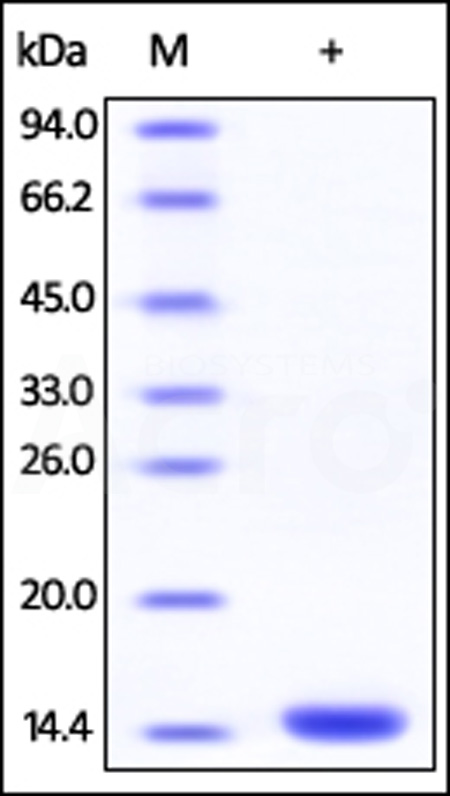分子别名(Synonym)
FKBP1A,FKBP1,Calstabin-1,FKBP12,Rotamase,PKC12,PPIASE
表达区间及表达系统(Source)
Human FKBP12, His Tag (FKA-H5122) is expressed from E. coli cells. It contains AA Met 1 - Glu 108 (Accession # P62942-1).
Predicted N-terminus: Met 1
Request for sequence
蛋白结构(Molecular Characterization)

This protein carries a polyhistidine tag at the C-terminus.
The protein has a calculated MW of 12.8 kDa. The protein migrates as 13 kDa under reducing (R) condition (SDS-PAGE).
内毒素(Endotoxin)
Less than 1.0 EU per μg by the LAL method.
纯度(Purity)
>95% as determined by SDS-PAGE.
制剂(Formulation)
Lyophilized from 0.22 μm filtered solution in 50 mM HEPES, 150 mM NaCl, pH7.5. Normally trehalose is added as protectant before lyophilization.
Contact us for customized product form or formulation.
重构方法(Reconstitution)
Please see Certificate of Analysis for specific instructions.
For best performance, we strongly recommend you to follow the reconstitution protocol provided in the CoA.
存储(Storage)
For long term storage, the product should be stored at lyophilized state at -20°C or lower.
Please avoid repeated freeze-thaw cycles.
This product is stable after storage at:
- -20°C to -70°C for 12 months in lyophilized state;
- -70°C for 3 months under sterile conditions after reconstitution.
电泳(SDS-PAGE)

Human FKBP12, His Tag on SDS-PAGE under reducing (R) condition. The gel was stained with Coomassie Blue. The purity of the protein is greater than 95%.
背景(Background)
Peptidyl-prolyl cis-trans isomerase FKBP1A, a member of the FKBP-type PPIase family and FKBP1 subfamily, is also known as FK506-binding protein 1A, immunophilin FKBP12 and 12 kDa FK506-binding protein, which contains one PPIase FKBP-type domain. FKBP1A is a cis-trans prolyl isomerase that binds the immunosuppressants FK506 (tacrolimus) and rapamycin (sirolimus).FKBP1A interacts with several intracellular signal transduction proteins including type I TGF-beta receptor. FKBP1A can also interact with multiple intracellular calcium release channels including the tetrameric skeletal muscle ryanodine receptor. Furthermore, FKBP1A can recruite SMAD7 to ACVR1B which prevents the association of SMAD2 and SMAD3 with the activin receptor complex, thereby blocking the activin signal.























































 膜杰作
膜杰作 Star Staining
Star Staining













